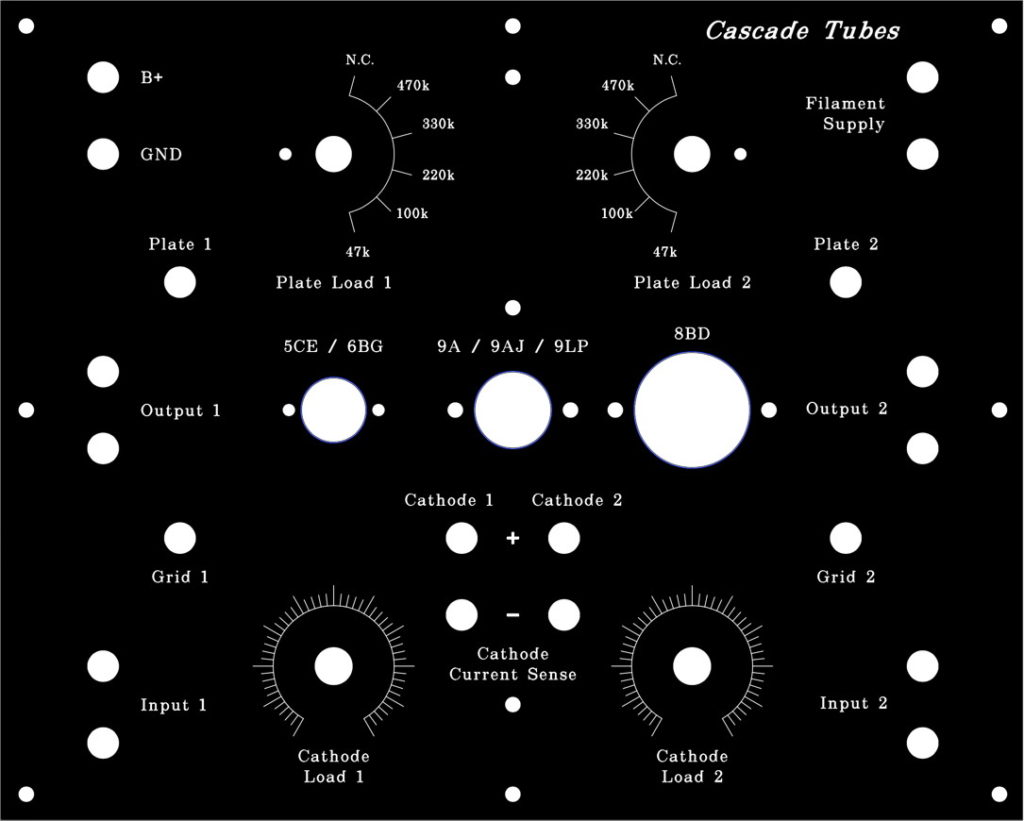The discussion on tube testers and their usefulness (or not) got me thinking about my own tube testing needs and how I go about it. I already have a solution for octal power tubes with the 7S base pinout which I’ve mentioned before. But what about those ubiquitous signal triodes I seem to use in almost every project? What should I do about them?
Anyone that’s been reading my website for a while knows that I like to build jigs and adaptors to make my job easier. I’ve built a full vacuum tube prototyping station. I’ve also built the power tube characterization jig for tubes like 6L6, 6V6, 6W6, KT66, etc. mentioned above. So I’m pretty much set for testing and trying out unique circuits and a good cross section of power tubes. But by far the most numerous tubes in my stash are signal triodes; most in a dual triode configuration.
So the big question is how to run through a whole set of these tubes and characterize their operation. As I said in the post about tube testers:
“An actual operating test in the application will give the best possible indication of a tube’s worth.”
But I decided that I needed something dedicated to address these tubes. I didn’t want a vacuum tube tester because that doesn’t really allow me to characterize the signal tubes’ operation. But I wanted more than a simple test jig. I wanted to be able to truly characterize the triodes in the types of circuits I build. I think I’ve settled on a solution.
I have designed a test jig for dual triodes which puts them in a common cathode triode amplifier configuration. The jig will require the use of a power supply, signal generator, multimeter, and oscilloscope. As I said, this is not a self contained tube tester but a jig for characterization. This will allow me to quickly characterize a set of tubes looking for performance potential, bad tubes, and even distortion characteristics.
The design has variable cathode loading for cathode bias and variable plate loads for exploring different plate current levels. The B+ supply will reference the plate loads and I can tune for cathode voltage or current levels with the variable cathode load. I decided to use three different sockets. First an 8 pin octal socket for the dual triodes with the 8BD base pinout (e.g. the 6SN7, 6SL7, etc.). Then a 9 pin miniature socket for all the common dual triodes with the 9A, 9AJ, and 9LP base pinouts (e.g. 12AU7, 12AX7, 6DJ8, 6CG7, etc.). And finally I’ve included a 7 pin miniature socket for the 5CE and 6BG base pinout. This is specifically for testing 6C4 single triodes (e.g. 1/2 of a 12AU7) and 6AB4 single triodes (e.g. 1/2 of a 12AT7). I use these single triodes in small projects more than I realized at first. I must have at least thirty of these in my tube stash at the moment.
I also decided on an indulgence for this project. There is a local company near me that does custom equipment panels. You design the panel yourself using their software, send them a design file, and they do all the milling and finishing work. It’s not cheap but I’ve wanted to try out their services for a while now and this seemed like the perfect opportunity. So here is the design I submitted this morning for my test jig panel.
If it turns out well (I have no reason to think it won’t) then I’ll provide more information on the company and their services. This will also allow me to build it without have to worry about marking and painting in my very cold workshop.
I am looking forward to this project. It should be fun and useful. When complete, I’ll post a project page with all the details.


Pingback: The “Indulgence” | Cascade Tubes
Pingback: Expanding Horizons | Cascade Tubes
Matt, Thanks for the original project. Reading through your thoughts, I appreciate the mental energy it takes to engineer this instrument. I am looking forward to seeing the wiring pictures and testing procedures. Dan